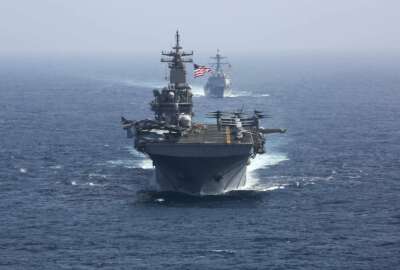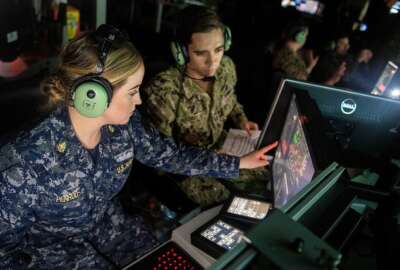
Navy still struggling with on time vessel maintenance
Navy vessels stay consistently in maintenance bays longer than scheduled. Navy cites lack of shipyard capacity as one reason. But there's more according to the...
Best listening experience is on Chrome, Firefox or Safari. Subscribe to Federal Drive’s daily audio interviews on Apple Podcasts or PodcastOne.
When it comes to keeping its fleets of ships and submarines ready, the Navy has a problem it just can’t seem to solve. Namely, vessels stay consistently in maintenance bays longer than scheduled. The Navy has cited a lack of shipyard capacity as one reason. But there’s more according to the latest in a string of Government Accountability Office reports. For the latest, the GAO’s director of defense capabilities and management issues, Diana Maurer, spoke with Federal Drive with Tom Temin.
Interview transcript:
Diana Maurer: What we found most recently was that if you look back over the course of the last six years, on average, the Navy lost the ability to use 15 ships every year, all six of those years, due to maintenance delays, and that’s across aircraft carriers, submarines, and the surface fleet. So things like cruisers, destroyers, minesweepers, those kinds of things. So it’s a systemic issue for the Navy. It’s a significant problem. Our most recent report, which we issued about a week or two ago, was a look at a Navy report the Congress asked them to do. Congress has been tracking this as well. And they said in last year’s National Defense Authorization Act is that Navy tell us why you’re consistently late, and what you’re doing about it. Our report looked at the Navy’s report to the Congress.
Tom Temin: And the Navy did cite some reasons. But it seems that you found they left out quite a number of causes, which would lay the blame to a larger degree on the Navy itself.
Diana Maurer: Exactly. So to the Navy’s credit, they focus quite a bit in their report on some of the pure maintenance infrastructures. So for example, the Navy talked about not having sufficient number of workers, they talked about not having sufficient capacity, which means they felt they needed more dry docks and better equipment and so forth. A big growing issue for the Navy is the shrinking vendor base. There are fewer companies within the US who are making the parts that the Navy and other services, frankly, need to repair and sustain major weapon systems. So that’s the problem. So the Navy report talked about all those things. What it didn’t talk about were some of these other more foundational issues, for example, acquisition, right. So when the Navy is planning to build new ships and when it’s actually building new ships, they’re baking maintenance problems into new systems. That’s a significant problem. Also, operationally, the Navy has been using ships longer than planned. So when they come into the port for repair, more things need to be fixed than planned. And they’re also deferring maintenance, in part because there’s not a sufficient number of crew aboard a variety of ships. And that’s another problem that we have pointed out for a number of years.
Tom Temin: Yes, because that idea of crew size really plays into the fact that a lot of maintenance happens while underway. And if you let things that while we can still get back to base or we can still complete this circuit without fixing this, it just makes the fixing much more major when the ship finally does come in.
Diana Maurer: That’s exactly right. So the Navy’s concept for keeping ships maintained starts with the crew. Right. The crew should be fixing the ship while its out at sea. Well, what’s been happening is that there aren’t sufficient number of crew members, and they’re being in many cases used for longer and longer shifts and longer hours. So the maintenance has been deferred, right. They’re trying to meet operational requirements, which is understandable, but it’s pushing the maintenance needs to the right. And when the ships going into port, there are more problems than there should be.
Tom Temin: When it comes to the requirements and acquisition issues, I know the Army has complained in some cases that there is too much reliance on contracts, which obligate only the vendor to be able to do major maintenance, such as on engines and transmissions of vehicles. Does that phenomenon happen in the Navy also?
Diana Maurer: Yes, that’s certainly a problem that we found it in some systems. I think the most notorious examples where the Littoral Combat ship, which is for the Navy, a relatively small ship designed to sort of work in close to shore. And the Navy’s concept for that ship was that nearly all of the maintenance was supposed to be done by contractors. And to simplify a very long story, that’s not working. It was not working, the Navy is in the process of changing that approach. And having more Navy involved maintenance, that takes a lot of time to come up to speed, to get the technical data, have the expertise to fix the ship. If you plan for many years not to fix it yourself and suddenly you’re pulling it back from the contractors, you realize you can’t fix the thing you bought. And that’s a major problem.
Tom Temin: And at some level, this issue is not just financial and operational, doesn’t it add up to national security. I mean, we have a new administration presumably coming in, and they may need the Navy as an instrument of national security, and the ships won’t be there to deploy.
Diana Maurer: You’re absolutely right, Tom. One way to think about doing maintenance even better is that it becomes a force multiplier. I mean, right now, there’s a significant and an important debate within the DoD and the Congress about the appropriate size and composition of the Navy. If you’re able to add 15 more ships to the fleet simply by performing maintenance on time every year, that’s a major contribution. And the Navy is more focused on this problem, there’s greater leadership attention, but there’s still quite a ways to go.
Tom Temin: And as they pivot from the whatever it was 345 ship to the 500 and some smaller, cheaper ship strategy, which the current Secretary of Defense recently named, then the inefficiency has greater numbers under it, if the same issues persist with the new style ships.
Diana Maurer: Exactly. I mean, one thing to think about is, regardless of your views on the size and composition of the Navy, what it should be, however you weigh in on that issue, you have to think about how are you going to maintain and sustain that Navy. And right now the Navy has been struggling to maintain the fleet that it has, if it’s going to grow to 355 or 500, or whatever in the future. It also needs to grow its maintenance and support capabilities.
Tom Temin: So what can Congress do possibly there were no recommendations in this current report that you have noted that in the last several half dozen reports on this issue, there have been recommendations, but maybe Congress needs to take a look at this in maybe the next NDAA.
Diana Maurer: Right, exactly. So and you’re absolutely right, Tom. In our prior work, we’ve made about 37 different recommendations on different aspects of Navy maintenance, the Navy’s agreed with nearly all of those, which is encouraging. From a congressional perspective, you know, any additional support that they can give to encourage the Navy to implement our recommendations is going to help. But more broadly, I think from a congressional decision making perspective, it’s important to think about the full spectrum not just about building new ships, but also maintaining the ships we have and how we’re going to maintain the fleet of the future. That all needs be part of the conversation and the discussion.
Copyright © 2025 Federal News Network. All rights reserved. This website is not intended for users located within the European Economic Area.
Tom Temin is host of the Federal Drive and has been providing insight on federal technology and management issues for more than 30 years.
Follow @tteminWFED





